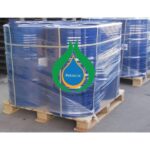Abstract
Background
Formic acid (format) is the main reason for toxicity and death through methanol poisoning. The simultaneous determination of methanol, ethanol, and format in the body can help to discover the cause of death and is useful in the diagnosis of acute methanol poisoning. The measurement of format is not yet available in Iran. With regard to the increasing rate of methanol poisoning and its related mortality in Iran, as well as the main role of format in methanol poisoning, this study was designed to set up an analytical method for the concurrent determination of ethanol, methanol, and format.
Methods
Following the modification of a previously developed gas chromatography method, vitreous and blood samples of 43 postmortem cases with a history of methanol intoxication were collected over a period of 2 years at the Legal Medicine Organization of Mashhad. Thereafter, ethanol, methanol, and format concentrations were measured by headspace GC/FID. Format esterification was performed by the methylation of format with sulfuric acid and methanol. In order to confirm the esterification method for the production of methyl format, we used gas chromatography with a mass detector (GC/MS) because of its higher sensitivity and accuracy. Furthermore, the correlations between format and methanol concentrations in blood and vitreous samples, and between format and methanol were investigated.
Results
A significant relationship was found only between methanol concentrations in blood and vitreous samples (P < 0.03).
Conclusions
In postmortems, with the passage of time since alcohol ingestion, the measurement of only methanol concentration cannot determine the degree of toxicity or the cause of death. Therefore, using the present analytical method and measurement of formic acid, we can estimate the degree of toxicity and cause of death.
Background
Methanol (wood spirits) is a widely used commercial and industrial alcohol. It is also found in the production process of non-standard alcoholic beverages using grape twigs [1]. In the human body, it is first metabolized to formaldehyde by alcohol dehydrogenase in the liver. Then it is converted to formate, which, in turn, is transformed to CO2 and H2O [1.2.3]. Methanol itself has low toxicity, and there is a relatively negligible correlation between toxicity or mortality and methanol blood or serum concentrations [4.5]. Formaldehyde is very toxic but it has a short half-life and does not accumulate; hence, no considerable formaldehyde concentrations are found in body fluids and tissues following the administration of methanol. Formic acid is considered to be the main toxic compound produced in the course of methyl alcohol metabolism. Formic acid accumulates in the body and is the main reason for toxic effects and death through methanol poisoning. Commonly reported adverse effects related to high serum concentrations of formic acid include visual damage, optical nerve injury, abdominal problems, nausea, and headache. Subsequently, high formic acid concentrations result in respiratory problems, renal failure, and finally lead to coma and death. Therefore, it seems necessary to determine the serum concentrations of methanol and especially of formic acid, in order to evaluate the causes of these observed adverse effects.
The measurement of formate is not yet available in Iran. With regard to the increasing rate of methanol poisoning and its related mortality in Iran, and also to the role of formate in methanol poisoning and the importance of its measurement in determining the causes of poisoning and death , this study was designed to set up an analytical method for the detection of formic acid in human samples. While flame ionization detectors (FIDs) are commonly used to measure methyl and ethyl alcohol, they are almost unable to determine formate concentration . An esterification step is needed for formic acid detection . Enzymatic methods have also been used to determine the formate concentration . Headspace gas chromatography (HSGC) has been utilized for the detection of formic acid using sodium propionate as an internal standard Also, the GC/MS has recently been used for the detection of formic acid .
No alt text provided for this image
In the present study, using a previously developed gas chromatography method with some modification , we simultaneously measured formic acid, methanol, and ethanol concentrations in 43 postmortems of vitreous and blood samples by headspace GC/FID. Furthermore, we investigated the relationship between concentrations of analytes in blood and vitreous samples.
Methods
Methyl formate, formic acid (95%), sulfuric acid (97%), ethanol (96%), methanol, acetonitrile (99.9%), dichloromethane, and distilled water were purchased from Merck Company (analytical grade).
Sample collection and storage
In the present study, 43 victims who died of methanol poisoning were investigated from April 2014 to April 2016. This work was approved by Tehran Legal Medicine Research Center Ethics Committee. All bodies were transferred to the Mashhad Legal Medicine Organization (LMO) within 24 h of death. For all cases, the interval of time between death and sampling was less than 24 h. Also, the interval of time between sampling and the analyses of the samples was less than 2 h. All autopsies of major organs were studied together with a review of clinical histories. Blood and vitreous samples were analyzed to determine methanol, formic acid, and ethanol concentrations. Blood samples were taken from the femoral region and stored in tubes containing sodium fluoride (NaF). All the blood and vitreous (without preservatives) samples were stored at −4 °C. Moral consent was taken from the family of the deceased before the experiment.





